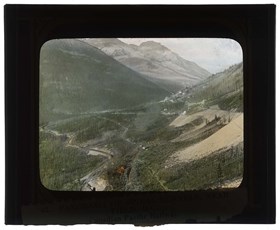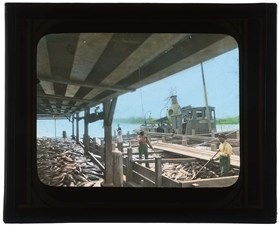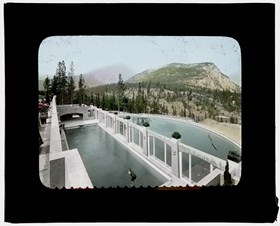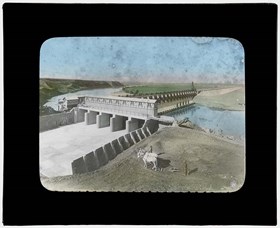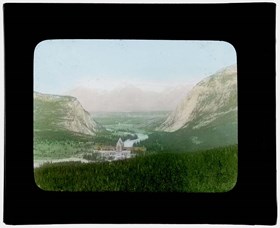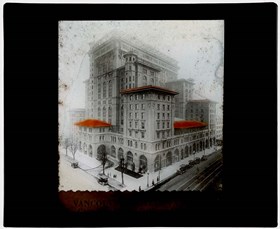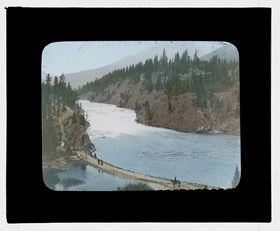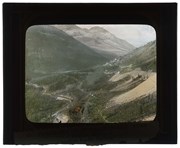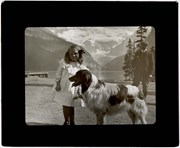Narrow Results By
- Luxton family fonds 72
- Vaux family fonds 45
- Mary Schaffer fonds 40
- Moore family fonds 23
- Nicholas Morant fonds 13
- Dorothy Wardle fonds 10
- Kidney family fonds 10
- Trail Riders of the Canadian Rockies fonds 7
- Jean A. Hembroff MacDonald fonds 6
- Archives General File Collection
- Caroline Hinman fonds 5
- Kay Powell fonds 3
Placido Monachello fonds
https://archives.whyte.org/en/permalink/descriptions55698
- Part Of
- Placido Monachello fonds
- Scope & Content
- Fonds consists of photographs pertaining to Placido Monachello and family; and a bound publication titled "Machinery's Handbook", 1943, which belonged to Placido. 12 photographs pertain to Placido's experiences at the Alternative Service Corps work camp at the Spray River Trail near Banff Springs H…
- Date Range
- 1941-1943
- [ca.1950-1960]
- 2010
- Reference Code
- M582 / V803
- Description Level
- 1 / Fonds
- GMD
- Digital image
- Photograph
- Photograph print
- Published record
- Textual record
- Part Of
- Placido Monachello fonds
- Description Level
- 1 / Fonds
- Fonds Number
- M582 / V803
- Sous-Fonds
- M582 / V803
- Accession Number
- 2020.25
- Reference Code
- M582 / V803
- Date Range
- 1941-1943
- [ca.1950-1960]
- 2010
- Physical Description
- ca.172 photographs : b&w prints -- 3 digital files : col. JPG images -- 4 cm of textual records (1 volume)
- History / Biographical
- Placido Monachello (1920-2018) received a conscription notice to join the war effort between 1940-1941. Placido opposed the conscription notice, identifying himself as a Conscientious Objector who refused to participate in the war. After appealing his case in court, Placido was sentenced to one year of work in an internment/work camp. Placido completed his year of work at the Alternative Service Corps work camp, located near the Sunshine Road/Brewster Creek area (ASW Camp No. 1). While at the work camp, Placido aided in the clearing of land and road construction around Banff. Placido returned home to Hamilton, Ontario in 1942, where he worked odd jobs as a labourer and farm hand. Placido married his partner, Leonarda "Leona" (Borsellino) Monachello (1920-2019) in 1944, with whom he later had two children, John and David. Placido sent numerous letters and photographs to Leona during his time at the ASW camp. While Placido was in Banff, Leona directly supported the war effort as an employee at Westinghouse in Hamilton, Ontario, where she produced high-tech military components. Placido and Leona ran two delicatessen businesses together after the war, one of which was initially funded by her parents. The couple sold their business in the 1970s, after which Placido worked for Stelco (a steel manufacturing company) until 1985. Placido and Leona took a trip to visit Banff together in 2010.
- Scope & Content
- Fonds consists of photographs pertaining to Placido Monachello and family; and a bound publication titled "Machinery's Handbook", 1943, which belonged to Placido. 12 photographs pertain to Placido's experiences at the Alternative Service Corps work camp at the Spray River Trail near Banff Springs Hotel (ASW Camp No. 1). ca.160 photographs pertain to Placido's family and personal life, including his wedding to Leonarda (Leona) in 1944 and their children [ca.1950s]. Fonds also includes 3 digital images of Placido and Leona visiting Banff in 2010.
- Name Access
- Monachello, Placido
- Monachello, Leona
- Subject Access
- World War II
- Family and personal life
- Internment Camps
- Settlement
- Labour
- Geographic Access
- Canada
- Alberta
- Banff
- Ontario
- Hamilton
- Language
- English
- Title Source
- Title based on contents of fonds
- Processing Status
- Unprocessed
This material is presented as originally created; it may contain outdated cultural descriptions and
potentially offensive content.
Read more.
Annotated copy of Alpine Flora of the Canadian Rockies
https://archives.whyte.org/en/permalink/descriptions57633
- Part Of
- Archives General File Collection
- Scope & Content
- File consists of one copy of the book "Alpine Flora of the Canadian Rockies" (1907) with a note written on the first page from the illustrator Mary Schaffer to Molly (Wright) Adams in December 1907.
- Date Range
- 1907
- Reference Code
- M8 / accn. 2023.63
- Description Level
- 5 / File
- GMD
- Published record
- Part Of
- Archives General File Collection
- Description Level
- 5 / File
- Fonds Number
- M8
- V8
- S8
- Sous-Fonds
- M8
- Accession Number
- 2023.63
- Reference Code
- M8 / accn. 2023.63
- GMD
- Published record
- Date Range
- 1907
- Physical Description
- 1 volume
- Scope & Content
- File consists of one copy of the book "Alpine Flora of the Canadian Rockies" (1907) with a note written on the first page from the illustrator Mary Schaffer to Molly (Wright) Adams in December 1907.
- Name Access
- Warren, Mary Schaffer
- Schaffer, Mary
- Wright, Mary
- Adams, Molly
- Subject Access
- Artist
- Art
- Flowers
- Plants
- Mountains
- Publication
- Environment
- Geographic Access
- Canadian Rocky Mountains
- Language
- English
- Category
- Environment
- Title Source
- Title based on contents of file
- Processing Status
- Processed
This material is presented as originally created; it may contain outdated cultural descriptions and
potentially offensive content.
Read more.
Canadian Pacific Railway Lantern Slides
https://archives.whyte.org/en/permalink/descriptions16400
- Part Of
- Archives General File Collection
- Scope & Content
- Series consists of 14 lantern slides [ca.1900-ca.1925]. Slides are views along the Canadian Pacific Railway.
- Date Range
- [c. 1905]
- Reference Code
- V8 / 5486 / PS - 1 to PS - 14
- Description Level
- 3 / Series
- GMD
- Transparency
- Lantern slide
14 images
- Part Of
- Archives General File Collection
- Description Level
- 3 / Series
- Fonds Number
- M8 / V8 / S8
- Series
- Accession Number: 5486
- Sous-Fonds
- V8
- Accession Number
- 5486
- Reference Code
- V8 / 5486 / PS - 1 to PS - 14
- Date Range
- [c. 1905]
- Physical Description
- 14 photographs : b&w and col. slides ; 10.2 x 8.2 cm
- History / Biographical
- The Canadian Pacific Railway (CPR) was officially formed in Februray, 1881, to construct a railroad that would link the eastern provinces with British Columbia, a key component of the Canadian Confederation of 1867. Headed by William C. Van Horne as General Manager, the railroad arrived in the Canadian Rockies in 1883 and a siding was established just east of present-day Banff. When railroad workers discovered a natural hot spring on the south side of the Bow River, Van Horne ordered the construction of a hotel that would house visitors brought in by train to visit the springs. Construction of the Banff Springs Hotel finished in 1888 and joined a handful of CPR hotels throughout the Rocky and Selkirk Mountain ranges. The popularity of the hot springs and surrounding area led to the formation of a national park and to the town of Banff. After construction of the railway had completed, the CPR continued to survey and document the Rocky Mountains alongside federal agencies like the Department of the Interior and private outfitters. Utilizing coloured lantern slides the CPR was able to showcase the mountains as both tourist and settlement destinations. Magic lantern shows of these slides could be used for administrative purposes by the company to showcase land holdings and investments or in public shows as advertisements of the new railway.
- Scope & Content
- Series consists of 14 lantern slides [ca.1900-ca.1925]. Slides are views along the Canadian Pacific Railway.
- Name Access
- Canadian Pacific Railway
- Subject Access
- Lantern slide
- Education
- Tourism
- Travel and Exploration
- Trains
- Geographic Access
- Banff
- Lake Louise
- Alberta
- British Columbia
- Canada
- Language
- English
- Conservation
- All slides were cleaned prior to scanning.
- Creator
- Canadian Pacific Railway
- Biographical Source Notes
- https://cpconnectingcanada.ca/#building-the-railway
- Title Source
- Title based on contents of series
- Processing Status
- Processed
Images
This material is presented as originally created; it may contain outdated cultural descriptions and
potentially offensive content.
Read more.
Children's Coloured Lantern Slides
https://archives.whyte.org/en/permalink/descriptions54644
- Part Of
- Archives General File Collection
- Scope & Content
- Series contains 35 children's magic lantern slides done in colour, machine-printed rather than hand-painted. There are 4 distinct grouping of the slides: 2019.88-1-12 depict the story "The Transvaal War" [manufactured in 1895?]. Each slide has 3 seperate images with black borders and are numbered s…
- Date Range
- [c.1895]
- Reference Code
- V8 / 2019.88 / PS - 1 to PS - 35
- Description Level
- 3 / Series
- GMD
- Transparency
- Lantern slide
35 images
- Part Of
- Archives General File Collection
- Description Level
- 3 / Series
- Fonds Number
- M8 / V8 / S8
- Series
- Accession Number : 2019.88
- Sous-Fonds
- V8
- Accession Number
- 2019.88
- Reference Code
- V8 / 2019.88 / PS - 1 to PS - 35
- Date Range
- [c.1895]
- Physical Description
- 35 photographs : col. slides ; 6.5 x 22.5 cm
- History / Biographical
- The Ernst Plank Company (EP) was located in Nerumberg, Germany and operated from 1866 until 1930. The company was known for their production of copper and tin toys, specifically stationary and locomotive toy steam engines and carriages, they also produced a variety of magic lanterns and lantern slides. When they first began producing lantern slides, the standard shape of a slide was a square piece of glass about 8cm x 8cm and, depending on the style of magic lantern being used, may have a wooden frame built around the glass. Styles changed as methods for printing slides and lantern designs advanced – by the 1880’s the wooden frame was removed entirely from the slides and replaced with thin strips of coloured binding tape that protected fingers from the glass edges. Originally, hand painted black silhouette images on glass or wax paper were used to create projected pictures, followed closely by the use of colour paints to create entire scenes. Printed images soon replaced hand-painted slides, allowing for cheaper production and more widespread use. A popular format for commercially manufactured lantern slides was a long piece of glass (usually no more than 23cm long) on which multiple images could be printed in order to tell a smoother story. This allowed for two different kinds of display. The first display has smaller pictures printed in circular or square frames with a solid black border and shown as independent images of a larger narrative with pauses in between. The second display option for these slides is as a panoramic scene with the entire area coloured in (or just with figures displayed like on a stage) so they could seamlessly slide from one side to the other. This long thin kind of slide was ideal for home use and could be easily handled by children. Ernst Plank also produced a toy magic lantern out of lightweight tin that could be lit with a small oil lamp specifically for use by children. Slides meant for that kind of lantern were printed on celluloid or on a single plane of glass with a thin layer of transparent lacquer to protect the image. This created a thinner, more lightweight and less delicate slide ideal for small hands. When a toy magic lantern was purchased it came with 1 or 2 sets (each set consisting of 12 slides) in the lantern’s box, additional sets of a particular theme could be purchased independently. Magic lanterns varied greatly in design and material depending on the use. Professional showmen would have multi-lens lanterns lit by powerful chemicals or high-voltage lightbulbs that would allow them to project clear images onto a large screen for a theater audience. There were also simpler lanterns that could be powered by oil lamps, multi-wick candles, gas lighting, or electricity in the home. One of the most popular themes for slide shows where images from international travel, but domestic scenes, Christmas, and famous historic battles were also very common.
- Scope & Content
- Series contains 35 children's magic lantern slides done in colour, machine-printed rather than hand-painted. There are 4 distinct grouping of the slides:
- 2019.88-1-12 depict the story "The Transvaal War" [manufactured in 1895?]. Each slide has 3 seperate images with black borders and are numbered sequentially so that the showman could keep track. There is no maker's mark, but according to a note placed in the accompanying lantern slide box, this set was made by the Ernst Plank Company. The slides depict protraits of men in various uniforms, battle scenes, and soldiers in uniform. Each silde is bordered with green paper in good condition.
- 2019.88-13-16 are unrelated EP slides bordered in red paper of varying condition. 13 has 4 travel images seperated with a black border; 14 is a long slide showing 4 boys in play dress as a marching band; 15 is a panoramic sea scape with ships and a harbour. A section of the coloured glass along the top slightly to the left of centre has been chipped off; 16 is a panoramic pastoral Dutch scene set in the springtime. The supporting glass piece has been badly damaged and is missing on the left end of the slide.
- 2019.88-17-28 are all travel scenes with 4 images to a slide seperated with a black border and no maker's mark. The images contain a mixture of people, animals, buildings and temples (mainly made from stone), boats, and landscapes from North America, Africa (with an emphasis on Egypt), and what could be either South America or Eurasia. All slides are bordered in red paper of fair to good condition.
- 2019.88-29-35 are unrelated EP slides of various styles bordered in red paper in fair to good condition. 29 depicts 4 caricature portraits with a black border; 30, 32, 34 are long slides with 4 individuals on each that are not seperated from eachother with borders, but are not part of a larger scene; 31, 33, 35 are all panoramic pastoral Dutch scenes set in both springtime and winter.
- Notes
- Accompanying the slides is what appears to be an original lantern slide box, made of wood and covered in faded purple paper with a steam engine train image on the top and a logo containing the intials "E.P." The logo consists of a 4-spoke wheel with wings on either side and 3 stars above. One short end of the box is missing and the sliding lid is either warped or stuck and does not open. A sticky note placed inside the box states that the green-line lantern slides (2019.88/PS-1 to PS-12) accompanied the box.
- Subject Access
- Lantern slide
- Children
- Education
- Entertainment
- Language
- N/A
- Conservation
- New binding tape, supports for broken glass
- Creator
- Ernst Plank Company
- Biographical Source Notes
- https://www.luikerwaal.com/newframe_uk.htm?/merk_ep1_uk.htm
- https://libraries.psu.edu/findingaids/2328.htm#toc
- Title Source
- Title based on contents of series.
- Processing Status
- Processed
Images
This material is presented as originally created; it may contain outdated cultural descriptions and
potentially offensive content.
Read more.
Gladys Campbell McKillop Lantern Slide
https://archives.whyte.org/en/permalink/descriptions16347
- Part Of
- Archives General File Collection
- Scope & Content
- Series consists of 1 lantern slide by Mary Schaffer of Gladys Campbell McKillop with Walter Wilcox's dog at Lake Louise.
- Date Range
- 1905
- Reference Code
- V8 / 3548 / PS - 1
- Description Level
- 3 / Series
- GMD
- Transparency
- Lantern slide
1 image
- Part Of
- Archives General File Collection
- Description Level
- 3 / Series
- Fonds Number
- V8
- Series
- V8
- Sous-Fonds
- M8 / V8 / S8
- Accession Number
- 3548
- Reference Code
- V8 / 3548 / PS - 1
- Date Range
- 1905
- Physical Description
- 1 photograph : b&w slide ; 10 x 8.2 cm
- History / Biographical
- Gladys Campbell McKillop (1899-1985) was the daughter of Robert E. Campbell, a prominent guide and outfitter in the Lake Louise area starting in 1897. As a child, Gladys would have spent a lot of time around the Lake Louise Chalet, where her father's outfit was based, and its surrounding area. She was married to Donald D. McKillop (1899-1975) and the couple share a grave in Banff's old cemetary.
- Scope & Content
- Series consists of 1 lantern slide by Mary Schaffer of Gladys Campbell McKillop with Walter Wilcox's dog at Lake Louise.
- Name Access
- Glayds Campbell McKillop
- Subject Access
- Lantern slide
- Family and personal life
- Geographic Access
- Lake Louise
- Alberta
- Canada
- Language
- English
- Creator
- Warren, Mary S.
- Biographical Source Notes
- https://www.findagrave.com/memorial/113656736/gladys-henrietta-mckillop
- Title Source
- Title based on content of series
- Processing Status
- Processed
Images
This material is presented as originally created; it may contain outdated cultural descriptions and
potentially offensive content.
Read more.
Machinery's Handbook
https://archives.whyte.org/en/permalink/descriptions55720
- Part Of
- Placido Monachello fonds
- Scope & Content
- Item consists of a book titled "Machinery's Handbook: For Machine Shop and Drafting-Room" by Erik Oberg and F.D. Jones, printed by The Industrial Press in 1943. Throughout the book are slips of paper with various notes written by Placido Monachello - his named is signed twice inside the front cover.
- Date Range
- 1943
- Reference Code
- M582 / I / 1
- Description Level
- 6 / Item
- GMD
- Published record
- Textual record
- Part Of
- Placido Monachello fonds
- Description Level
- 6 / Item
- Fonds Number
- M582
- Series
- I : Books
- Sous-Fonds
- M582 / V803
- Accession Number
- 2020.25
- Reference Code
- M582 / I / 1
- Date Range
- 1943
- Physical Description
- 7 cm of textual records (1 volumes ; 12.0 x 18.2 cm)
- History / Biographical
- See fonds level description
- Scope & Content
- Item consists of a book titled "Machinery's Handbook: For Machine Shop and Drafting-Room" by Erik Oberg and F.D. Jones, printed by The Industrial Press in 1943. Throughout the book are slips of paper with various notes written by Placido Monachello - his named is signed twice inside the front cover.
- Name Access
- Monachello, Placido
- Subject Access
- Books
- Industry
- Machinery
- Professional and Personal Life
- Language
- English
- Japanese
- Title Source
- Title based on item
- Processing Status
- Unprocessed
This material is presented as originally created; it may contain outdated cultural descriptions and
potentially offensive content.
Read more.
Miniature souvenir photograph collection, Stoney Nakoda portraits
https://archives.whyte.org/en/permalink/descriptions56932
- Part Of
- Archives General File Collection
- Scope & Content
- File consists of one souvenir collection of 16 miniature photographs by Byron Harmon in original envelope, titled "16 Miniature Photographs of Indians of Western Canada". Images include portraits of various unnamed Stoney Nakoda people [possibly including Hector Crawler and Leah Rider], teepees, an…
- Date Range
- [ca.1920-1940]
- Reference Code
- V8 / 2022.31
- Description Level
- 5 / File
- GMD
- Photograph
- Published record
- Part Of
- Archives General File Collection
- Description Level
- 5 / File
- Fonds Number
- M8
- V8
- S8
- Sous-Fonds
- V8
- Accession Number
- 2022.31
- Reference Code
- V8 / 2022.31
- Date Range
- [ca.1920-1940]
- Physical Description
- Souvenir photograph collection (16 photographs : b&w prints ; 4.5 x 7 cm)
- Scope & Content
- File consists of one souvenir collection of 16 miniature photographs by Byron Harmon in original envelope, titled "16 Miniature Photographs of Indians of Western Canada". Images include portraits of various unnamed Stoney Nakoda people [possibly including Hector Crawler and Leah Rider], teepees, and a totem pole.
- Notes
- Warning: Photographs include original titles, which contain derogatory and/or offensive language describing Indigenous people.
- Name Access
- Harmon, Byron
- Subject Access
- Photography
- Portrait
- Indigenous Peoples
- Teepees
- Totem pole
- Geographic Access
- Canada
- Alberta
- Morley
- Reproduction Restrictions
- Copyright restrictions may apply
- Language
- English
- Category
- Indigenous Peoples
- Title Source
- Title based on contents of file
- Processing Status
- Processed
This material is presented as originally created; it may contain outdated cultural descriptions and
potentially offensive content.
Read more.

